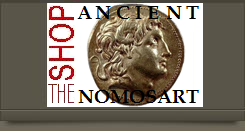
about ancient nomos
Ancient Nomos Art is a museum of galleries exhibiting ancient coins and ancient mint maps. The coin gallery displays the diverse art and history of hand-crafted ancient Greek, Roman, Byzantine, Persian and Medieval coinage. The ancient mints mapping gallery features Greek, Roman, Byzantine, Asia Minor and Medieval mint city regions and territories. Visitor's are welcome to explore, study and enjoy Ancient Nomos Art.

Roman Republic – 275 BC
Roman Apollo As
From Ancient Galleries

Obverse: Diademed head of Apollo facing right with hair tied back with a band.
Reverse: Diademed head of Apollo facing left with hair tied back with a band.

LEGEND
Obv: Diademed head of Apollo facing right with hair tied back with a band; denomination mark I above. Rev: Diademed head of Apollo facing left with hair tied back with a band; denomination mark I above.
From the eighth century to late fourth century BC, the Carthaginian, Greek and Etruscan cultures arrived in large numbers to populate the Italian peninsula in the regions north, south and east of Rome. Their four centuries of commercial, cultural and religious dominance in Italy was only eclipsed by the emerging Romans at the turn of the 4th century BC. The Romans issued their first coins after the Battle of Beneventum in 275 BC, which coincides with their very first victory against ancient Greece, defeating the army of Pyrrhus’ soldiers, including nearly a dozen elephants. By this time, the Romans were able to exert their controlling power over the entire peninsula. Remarkably, and despite the new Latin territorial dominance, the Romans did not mint their own coinage until 289 BC. The earliest of Roman coinage took the form of very large die-cast bronze discs, better known as the “aes grave” currency, circa 289 BC. The extremely rare Apollo-Apollo specimen above is regarded as one of the first genuinely Roman coin. The specimen has been cast precisely to the original Roman weight standard based on a libra (one pound), equivalent to 320 grams. Later aes grave coins would be cast to a diminishing weight standard. The Apollo-Apollo bronze unit denomination was called an As (pronounced “Ace”). The original libra As unit was divided into sub-units according to the Roman duodecimal system. Basically, the libra sub-units consisted of a Semis valued at 6/12th an As, Quincunx valued at 5/12th an As (see cast bronze Quincunx), Quadrans valued at 3/12th an As (see cast bronze Quadrans), and Uncia valued at 1/12th an As. The early aes grave As monetary units featured portraits of Apollo on the obverse and reverse. Later the coins famously featured the bearded bust of the god Janus on the obverse. On the reverse of most aes grave coins feature the prow of a ship (rostrum), as can be seen on the next ANAM Roman coin exhibit (see cast Janus and Prow As). In 289 BC, the value of an As was believed to be enough to pay for either a large bottle of wine or lodging for two nights with a meal. Over the next century, the very large original bronze As coinage underwent successive devaluations, dropping from 320 grams to 20 grams by the end of the 2nd Punic War. The Punic War ultimately led to major currency reforms and creation of the first Roman silver quadrigatus coinage (see Roman Republican silver Didrachm).
DOCUMENTATION
Value: As. Metal: Æ cast bronze. Weight: 333 grams. Original libral standard. Mint: Rome. Date: 275-270 BC.
Attribution: Crawford 18/1; Thurlow & Vecchi 8; Haeberlin pl.34, 1-35, 6; HN Italy 279; Italian Cast Coinage 33; Edward Waddell 1998, List 68, 116. Photo courtesy Bertolami Fine Arts.
EDGE VIEW OF APOLLO COIN

SPECIAL FEATURE EXHIBIT
The ANAM Special Features gallery examines the edge view of the Apollo (double portrait) coin and how ancient art and math can be utilized to explore and examine the earliest of Republican Roman bronze casting to reveal why this first series of coinage was issued in an unprecedented and exceptionally high-relief. To view the Special Features cast Apollo coin exhibit, please use the following link: Cast Apollo Special Feature Exhibit
Legend, Documentation and Attribution
